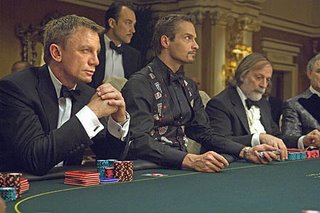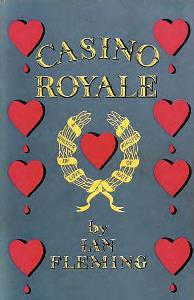Poker Review: Casino Royale
 Got a call yesterday from Vera Valmore (introduced a few posts back) who wanted to see Casino Royale. Neither of us is such a big James Bond fan, though I suspect Vera might have been at least somewhat intrigued by all of those images of a shirtless and brooding Daniel Craig wading off the coast of the Bahamas. And I knew there was supposed to be some poker in there somewhere. So we went.
Got a call yesterday from Vera Valmore (introduced a few posts back) who wanted to see Casino Royale. Neither of us is such a big James Bond fan, though I suspect Vera might have been at least somewhat intrigued by all of those images of a shirtless and brooding Daniel Craig wading off the coast of the Bahamas. And I knew there was supposed to be some poker in there somewhere. So we went.About forty years ago, Casino Royale was filmed as a one-off, messily-constructed, occasionally-funny spoof starring David Niven, Peter Sellers, and a young Woody Allen. The new version takes the same Ian Fleming novel as source material, reformulating it as a new story set in the present. As the first novel in Fleming’s series (published in 1953), Casino Royale introduces the character of Bond, telling how he first became a double-0 agent and relating his first adventure. Fleming's story has Bond tangling with a character named Le Chiffre (literally, “the number”), an agent for a Russian intelligence agency called SMERSH. Guilty of having lost SMERSH funds through a failed private venture (to start a chain of brothels), Le Chiffre must try to win back the money in a high-stakes baccarat game to take place at the Casino Royale in France. (Yeah, sure.) Enter Bond, an expert player, to compete against Le Chiffre in an effort to spoil the villain’s plan to avoid being killed for his transgression.
The new film updates the story by linking Le Chiffre to an unnamed terrorist organization operating in the summer of 2006. Here he’s managed to squander over $100 million of the terrorists’ money in a failed investment scheme. (Indeed, Bond’s own heroic thwarting of an act of terrorism causes Le Chiffre’s investment to fail.) Characterized as a “mathematical genius” and expert poker player, Le Chiffre identifies a high-stakes hold ’em game in Montenegro as the place to recup his losses. (Yeah, sure.) Incidentally, the actor who plays Le Chiffre, a Dane named Mads Mikkelsen, does have a vaguely Hellmuthian purse of the lips about him. And, of course, Bond -- “the best poker player in the Service” -- will be there as well.
I’m not as versed in Bond trivia as are the fanatics, but I have seen a few of the earlier entries starring Connery and Moore. (I must admit I never bothered to catch any of the later Dalton or Brosnan flicks.) This new Casino Royale was certainly more violent than the earlier films, something Ms. Valmore did not appreciate very much. The chase scenes (there had to have been four or five lengthy ones) went well with the medium-sized popcorn I was munching on as I watched, though as I think about it today both are probably equally memorable. The new film also seemed much less witty than the earlier films. Clearly the filmmakers’ placed a premium here on action, not dialogue. Not so much of Bond’s usual verbal sparring with villainous types here, nor even that many double entendres with the ladies. No, it appears those at the helm decided early on always to “cut to the chase” whenever possible.
Perhaps as a result of this emphasis on action, the filmmakers’ handling of the poker-playing sequences betrays an obvious impatience. There are a couple of very brief scenes involving poker that appear early in the film -- one each for Le Chiffre and Bond, establishing both as successful players. The big game at Montenegro (why Montenegro?) does take up a large portion of the film’s middle section, although even there it seems whenever play gets going the film can’t wait to get away from the table. Indeed, the game is interrupted not once but twice with lengthy (and brutal) action sequences. The first has Bond killing two terrorists during a scheduled break; the second involves an assassination attempt on the hero himself (needless to say, he survives).
The hands dramatized during this scene all include the (expected) unlikely showdowns between full houses and/or quads and/or straight flushes. Just like on the teevee, every hand shown culminates with an all-in. I suppose I could complain about these things, but to do so seems like it would miss the point. Rather, the relative lack of table talk during these sequences was -- for me -- the bigger letdown here. These guys say practically nothing at the table; it's as if the scriptwriters don’t have a clue about what poker players say to each other while playing. The filmmakers really missed an opportunity during the poker scenes (1) to build suspense and (2) to invigorate the script. Can’t believe I’m saying it, but even ESPN’s wayward Tilt series did a much better job using poker to build tension and interest in its otherwise silly plot.
(One other gripe . . . where’s the casino? We only really see the private room where the big game takes place -- it could well be in any randomly-chosen five-star European hotel. Why pass up the chance to offer more sensory-stimulating delights, especially in this kind of picture?)
A lot of folks are fawning over this here “rebooting” of the Bond franchise. Michael Phillips, James Berardinelli, Peter Travers . . . they’re all sayin’ 3½ out of 4 stars. Perhaps they’re all comparing this film to the more recent entries -- and/or to faded memories of the older ones. Personally -- and not just for poker-related reasons -- I didn’t think it was all that.
 Vera wasn’t too keen on the film, either. She’d probably hate the novel even more, as the film does tend to tone down the rampant misogyny one finds there. Now that I think about it, Fleming’s novel shares a lot of similarities with lower-tier hard-boiled fiction. The hero and plot particularly remind me of Mickey Spillane’s Mike Hammer stories. Aside from the international setting, Casino Royale bears many similarities to Spillane’s debut, I, the Jury (first published in 1947). Both feature hypermasculine heroes as protagonists. Both go way overboard with the graphic depiction of violence. Both have the hero fall head over heels for a woman who turns out to have double-crossed him (proving, of course, that women are evil). And both conclude with the hero confirming his “alpha-male”-status with hand-waving dismissals that the deaths of their respective femme fatales have any significance. When asked about killing his fiancée, Mike Hammer coolly replies “It was easy.” When the subject of his lover is brought up to Bond, he simply notes (in a line that does appear in the film) “The bitch is dead.”
Vera wasn’t too keen on the film, either. She’d probably hate the novel even more, as the film does tend to tone down the rampant misogyny one finds there. Now that I think about it, Fleming’s novel shares a lot of similarities with lower-tier hard-boiled fiction. The hero and plot particularly remind me of Mickey Spillane’s Mike Hammer stories. Aside from the international setting, Casino Royale bears many similarities to Spillane’s debut, I, the Jury (first published in 1947). Both feature hypermasculine heroes as protagonists. Both go way overboard with the graphic depiction of violence. Both have the hero fall head over heels for a woman who turns out to have double-crossed him (proving, of course, that women are evil). And both conclude with the hero confirming his “alpha-male”-status with hand-waving dismissals that the deaths of their respective femme fatales have any significance. When asked about killing his fiancée, Mike Hammer coolly replies “It was easy.” When the subject of his lover is brought up to Bond, he simply notes (in a line that does appear in the film) “The bitch is dead.”The Cincinnati Kid it ain’t, then. (I plan to write something here about the 1965 Norman Jewison film -- the best poker movie I have ever seen -- in the not-too-distant future. Perhaps I’ll start collecting a few more of these “poker reviews” to post . . . .) All told, Casino Royale is a slightly more entertaining linkage of poker and terrorism than that put forth by certain members of Congress over the last few months. But that’s about all the film has going for it, I’m afraid. (Aside from that hunky Daniel Craig, or so some tell me . . . )
Images: Casino Royale (film, 2006); Casino Royale (novel, 1953), Ian Fleming; Amazon.
Labels: *the rumble, film














6 Comments:
My son went to see this yesterday. he enjoyed it and he said there's loads of poker so I would like it too.
I must admit, I don't really like Daniel Craig. Would have preferred to have seen Sean Bean as james Bond.
Daniel Craig was okay, I thought. And it was entertaining -- the chases are excellent. Just didn't blow me away as it seems to have others.
i'm gonna watch that movie. if you want to play poker just drop this site it cool. Best Internet Casino Gaming
This comment has been removed by a blog administrator.
Hi Shamus,
I actually have to agree with you here, Im in the 'it wasn't all that' camp. Maybe its because I tend to wait a few weeks after a films release before I go to see it myself - and having to listen to 3 weeks worth of hype from friends etc. always leads up to an inevitable anti-climax.
How the hell the BBFC deemed the film fit to be a 12 certificate I'll never know. Scenes of torture..?? Hmmm sorry but my daughter wont be seeing this for a long while past her 12th birthday (if she'd ever want to that is). They seem to be going soft in their old age as I remember some equally violent scenes in M.I.3 and witnessing a 12 year old in front of me crying like a baby inbetween his parents who eventually took him outside.
Anyway, I ditract, I did like the film for the ridiculous poker, but I wont be buying it on DVD..
Caio!
Can somebody help me with a school assignment?
Q1) Identify many of the non verbals in the scene?
Q2) what messages are associated with those non verbals?
Q3) how do you know you are right?
Hint: the non verbals include the principals, people sitting around the table, the casino itself and what is not there.
Please help me
Post a Comment
<< Home